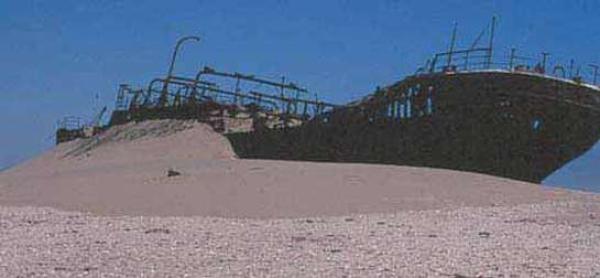

Set in a cluster of low hills is the town of Outjo, an important cattle ranching centre. The history of the town and surroundings is depicted in the Outjo Museum, with the focus on gemstones and wildlife. Dominating the landscape when travelling westwards en route to Khorixas, 95 km west of Outjo, is the Ugab Vingerklip (finger of rock) situated amongst the rugged Ugab Terraces. About 35 m high, this distinctive monolith has been moulded into its curious shape by erosion. In its shadow is the Vingerklip Lodge, strategically situated for tourists travelling between Etosha and the coast. Rock paintings can be viewed at Omburo Ost, a neighbouring farm.
A unique museum had its origins in 1915 when, during the South West Africa Campaign, retreating German forces dumped their military equipment into Lake Otjikoto, about 24 km north-west of Tsumeb. There the armaments lay, undisturbed, until members of the Windhoek Underwater Club recovered an ammunition carrier, now on display in Windhoek's Alte Feste Museum. On subsequent forays a number of cannons, machine guns and other weapons were retrieved. These form an important part of the displays in the Tsumeb Museum.
Since its inception in 1970, members of the club have explored the mysterious green waters of Otjikoto and discovered an underwater museum which qualified divers can now explore at a depth of 55 m. Covering an area of 25 m by 5 m, divers can view armaments and weaponry dating back to the First World War.
Many legends surround the lake. A favourite myth is that Otjikoto and its sister lake Guinas are bottomless. This misconception was given durability because the body of a former postmaster of Tsumeb, Johannes Cook, who drowned in Otjikoto in 1927, was never found. In fact, the depth of the lake varies from 33 to 90 m. Shaped something like an upside down mushroom, Otjikoto was formed when the roof of a huge dolomite cave collapsed. Stalactite samples taken from an underwater cave have been estimated to be about 80 000 years old.
A rare, mouth breeding species of fish is found in the lake's depths, as well as in Lake aquinas, which lies to the north-west of Otjikoto. The 130 m-deep Lake Guinas is noted for its beautiful setting and the ink-blue colour of its water. Visitors to Namibia who are qualified divers, are welcome to join golub members on a journey of underwater exploration at Lake Otjikoto.
Meteorites and memorials
The largest known meteorite in the world, the Hoba Meteorite, lies in a shallow depression on the farm Hoba-West about 20 km west of Grootfontein. The 50 ton mass of nickel and iron, which is between 100 million and 300 million years old, crashed to earth some 30 000 to 80 000 years ago. Discovered by Jacobus Hermanus Brits in the 1920s, it was periodically subjected to vandalism.
Measures to protect the meteorite were taken in the 1980s in a joint venture between Rossing Uranium Limited and the National Monuments Council. A stone amphitheatre was built around it to allow for convenient viewing, while a "museum wall" giving information on the meteorite was built at the entrance. There are barbecue facilities at the site.
The Khorab Memorial, about 3 km from Otavi, dates back to the First World War and marks the spot where the cease-fire was signed at Khorab on July 9, 1915.





